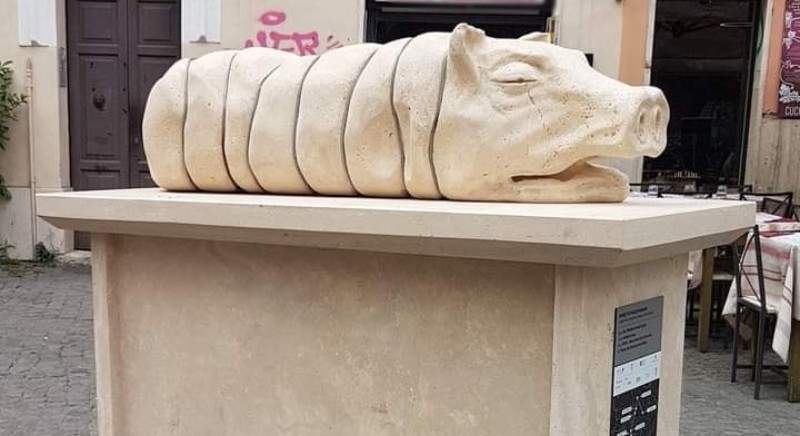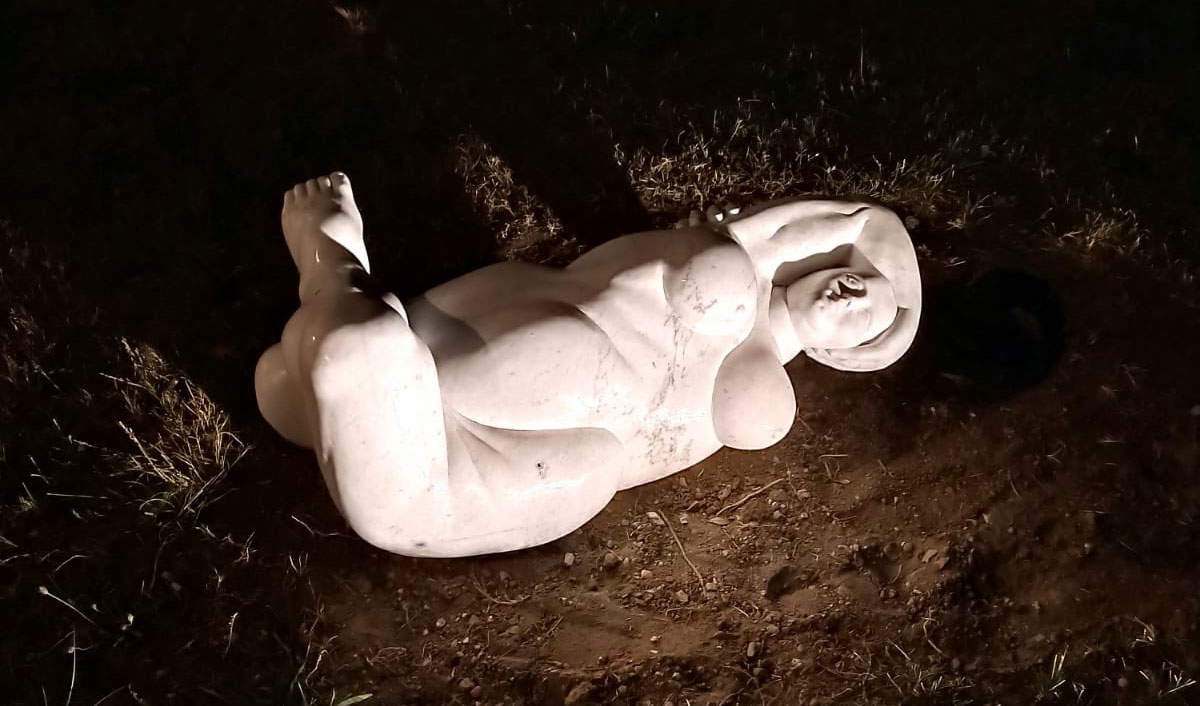Per the Treccani dictionary, the adjective “clumsy” means “anything that shows clumsiness, timidity, lack of ease,” or can refer to anything that is “lacking in grace, elegance, harmony, such that it is almost ridiculous.” Clumsy is, in essence, something clumsy, rough-looking, unable to move with agility in a given context. And it is perhaps the most apt adjective to describe a certain aesthetic strand within which some of the public art interventions of the last week can be inscribed: the much-discussed Trastevere porchetta, a travertine work by sculptor Amedeo Longo, Nicola Russo’s Toh bull installed in Turin, and Giorgio Andrei’s less famous but no less clumsy Vanity laid on bare earth in Marina di Carrara.
The three sculptures have all swooped onto the public square in the last week, are all united by a precise intentionality, by the officialdom of the context in which they were born and were presented (an “urban regeneration” project promoted by City Hall I in Rome for porchetta, a “temporary” donation aimed at sale with the purpose of donating part of the proceeds to cancer research and sponsored by the City of Turin for the Toh bull, and a donation welcomed willingly and with much official ceremony by the City of Carrara in the case of the Vanity), as well as by the very poor reception that much of public opinion and insiders gave to the operations. It has been said that these are works of bad taste or that they are ugly, expressions that in common understanding certainly do not refer to “bad taste” or “ugly” as aesthetic categories, without which, moreover, much of art history would not exist: a work by Grünewald is ugly, a work by Bruegel is ugly, a work by Schiele is ugly, a work by Asger Jorn is ugly, there is great ugliness even in the work of Dürer, Annibale Carracci and other greats whom we paradoxically praise for the “beauty” of their works, just as there are works by Duchamp, by Dalí, by Ontani founded on “bad taste,” in the Dorflesian sense of the expression. No: the Roman strolling through Trastevere who, coming across the travertine porchetta in Piazza della Malva, speaks of “ugly sculpture,” should not necessarily study Rosenkranz and Umberto Eco or see a hundred exhibitions on the twentieth-century avant-garde before speaking.
 |
| The Porchetta of Rome |
 |
| The Vanity of Carrara |
More simply, a rather precise mechanism is produced which is based, first of all, on that sense for beauty which, according to Desmond Morris, is congenital in every human being and which leads the passerby to judge, in the first instance, the sculpture by its degree of adherence to reality or at least by theharmony of its forms: this applies to a Vanity that takes the form of a female nude, but it can also apply to a porchetta or a bull. The poor imitation of reality or the clumsy formal imbalance of the whole therefore leads the passerby to speak of an “ugly” work: and in common speech, the adjective “ugly” is the quickest and most immediate adjective that is used to indicate something clumsy, badly made. To arouse public indignation also contributes, in some cases, the triviality of the subject, evident in the case of the porchetta: the vulgarity and baseness of the monument, however, are not sufficient to determine its clumsiness. Annibale Carracci’s Mangiafagioli is one of the most extraordinary masterpieces of the second half of the 16th century. There are great sculptors of the twentieth century who have carved pigs, goats, sheep, assorted foodstuffs. If one were to appeal to the height of the content, an artist like Claes Oldenburg would never have been allowed to exhibit his works in the public square around the world.The problem, therefore, is not the idea of dedicating a work to porchetta. Not to mention one of the sculptures that has been most juxtaposed by the public these days with the porchettona trasteverina, namely Maurizio Cattelan’s L.O.V.E., the middle finger in Piazza Affari that, in terms of ugliness and vulgarity, is certainly not second to the pig in Piazza della Malva.
What is it, however, that makes L.O.V.E. a masterpiece and Longo’s porchetta an awkward work? Starting from a basic level, since they are both imitation sculptures, Cattelan’s finger reveals a degree of adherence to reality that the porchetta fails to even touch (the fact that Cattelan had a sculpture workshop that gave shape to his idea is not, however, an argument in Longo’s favor). And again, L.O.V.E. conveys a sense of monumentality completely unknown to Dal panino si va in piazza (this is the title of Longo’s sculpture). Second, the furrow between Porchetta and L.O.V.E. is carved by the work’s multiple levels of interpretation, and consequently by the depth of its meaning. Longo, on the other hand, for his porchetta admonished the Romans with a very simple and ready-made meaning (only later was an attempt made to pass off the porchetta as a goliard, evidently to give the sculpture a new meaning once it was understood that to incorporate the primal one, which spoke of “desire for discovery,” “sharing,” “food of opposites,” “celebration of a tradition,” and so on, the work had evidently not worked). The same argument could be applied to Nicola Russo’s bull, whose meaning is rendered by the artist in an extremely banal and didactic form. Not to mention that Cattelan himself is well aware of how the meaning of a work is susceptible to change according to contexts and according to times. And this is also one of the reasons why the banana taped to the wall is a work of relational art at least worthy of being commented on, if proposed by Cattelan in a given context, and becomes instead a boutade devoid of merit if made by any carnivore at the sausage festival: in the same way, if by some absurdity behind the porchetta in Trastevere were to reveal the direction of a relational artist capable of having engineered everything as a great performance, then the meaning of the work would acquire a totally different sense. And yet another meaning would have been taken on by the porchetta if, say, it had been created not as a work to be exhibited in a square within an official context, but as the personal initiative of an outsider without any academic training, and therefore the authentic, genuine and sincere fruit of a disinterested creative urge. With the porchetta, on the other hand, we are faced with an artist who has distorted his own language (given that, as far as we can see, Longo’s previous creations have nothing to do with the poor roasted beast) evidently in response to a specific request, while in other cases the fact that there is a donation to a public institution leads, at the very least, to arouse suspicion about the pure urgency of the work.
Lastly, and most importantly, it is necessary to assess the result against the intention. The degree of clumsiness is directly proportional to the gap between intention and result. Labranca spoke of “trashiness” referring to the results produced by the intention to imitate a more or less lofty model. In our case this can apply both to Andrei’s Vanity, which seems to be a poor imitation of Botero, Marc Quinn or Henry Moore, and to which the definition of “trash” fits well, and to Longo’s porchetta, which in presenting it manifested in clear letters, in the official description, the intention to “resume the depiction of animals typical of classical Roman art.” A lofty model, then (the animals of classical Roman art), combined with the intention of conveying a certain idea (being together, wanting to share, discovery), and on the other hand an awkward result (the porchetta in Malva Square) that produces a hopelessly trashy work of art even in the Labranchian sense of the term.
It will therefore be necessary to serenely assess whether clumsiness can be worthy of becoming a conscious aesthetic category suitable for statues and monuments displayed in the public square, given that, moreover, the porchetta, the Toh bull and the Vanity are not isolated cases: there is now a widespread clumsiness, for example, in much of the traffic circle statuary(a production in which interesting monuments to the most varied typical products have been created, from the basil of Prà to the parmesan cheese, from lambrusco to the Taggiasca olive: it is clear that by now the monument is no longer a work responding to a high public interest, but a tool for marketing the specificities of the territory), but also in monuments erected to celebrate illustrious personalities (the more than clumsy monument to Gabriele d’Annunzio installed in Trieste comes to mind). But given the proliferation of clumsy monuments and works displayed in public, it seems that the problem is already largely overcome.
Warning: the translation into English of the original Italian article was created using automatic tools. We undertake to review all articles, but we do not guarantee the total absence of inaccuracies in the translation due to the program. You can find the original by clicking on the ITA button. If you find any mistake,please contact us.